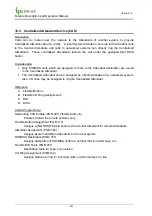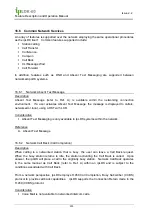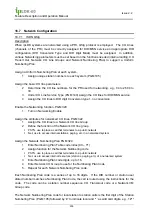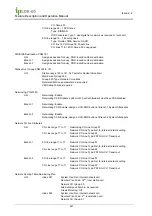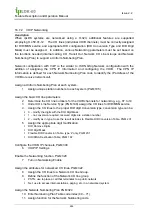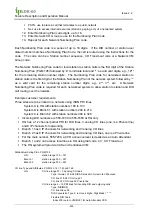
Issue 2.2
Feature Description and Operation Manual
239
16.7 Network Configuration
16.7.1
ISDN QSig
Description
When ipLDK systems are networked using a PRI, QSig protocol is employed. The CO Lines
(channels of the PRI) must be correctly assigned for DID/MSN service and appropriate DID
configuration (DID Conversion Type and DID Digit Mask) must be assigned. In addition,
various Networking parameters must be set based on the functions needed (internal calling, CO
Transit Out, Network CO Line Groups and Network Numbering Plan) to support a Uniform
Numbering Plan.
Assign a Uniform Numbering Plan at each system,
1. Assign unique station numbers to each system (PGM 105)
Assign the basic CO line parameters
2. Determine the CO line numbers for the PRI used for networking, e.g., 04 to 26 04 to
33
3. Under CO Line Service Type (PGM 140) assign the CO lines for DID/MSN service
4. Assign the CO lines to DID digit Conversion type 1, no conversion
Enable the Networking function, PGM 320
1. Turn on Networking Enable
Assign the attributes for networked CO lines, PGM 322
1. Assign the CO lines to a Network CO line Group.
2. Define the function of the Network CO line group
PSTN, use to place a call that terminates to a public network
Net, use to access internal stations, paging, etc. in a networked system
Assign the Network Numbering Plan PGM 324
1. Enter Numbering Plan Table code index (00 – 71)
2. Assign function for the Network Numbering code
PSTN, use to place a call that terminates to a public network
Net, use to access internal resources (stations, paging, etc.) of a networked system
3. Enter Numbering Plan code digits, up to 16.
4. Enter Network CO Group to use for the Numbering Plan Code
5. Repeat for each Network Numbering Plan code.
Each Numbering Plan code is a series of up to 16 digits. If the DID number or station user
dialed number matches a Numbering Plan Code, the call is routed using the instructions for the
code. The code can be a station number sequence, CO Transit-out code or a Network VM
Group code.
The Network Numbering Plan code for local station to station calls is the first digit of the Station
Numbering Plan (PGM 105) followed by ‘#’ to indicate local and ‘*’ as wild card digits, e.g., 1#**
Summary of Contents for ipldk-60
Page 1: ...Feature Description Operation Manual ...
Page 268: ......
Page 269: ...Admin Programming Manual ...
Page 388: ...ipLDK 60 Issue 2 0 Admin Programming Manual July 2010 113 Blank 1 2 3 ...
Page 512: ......







